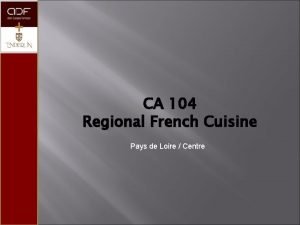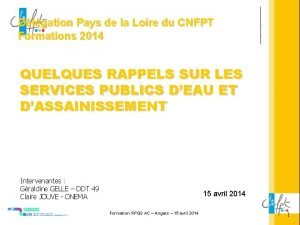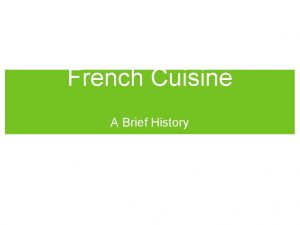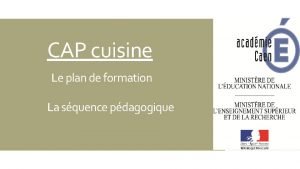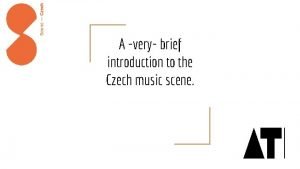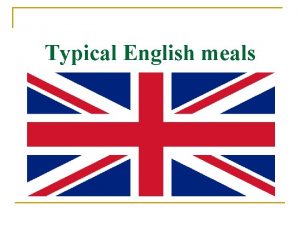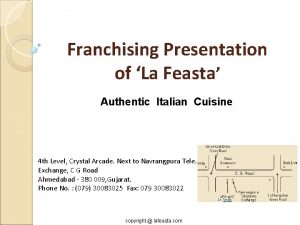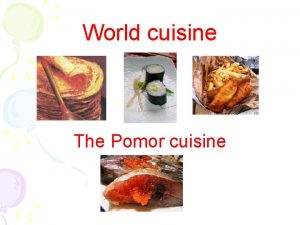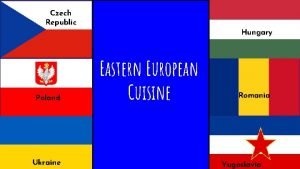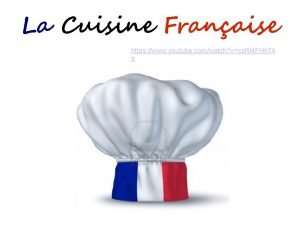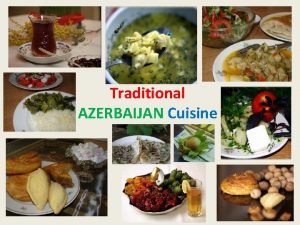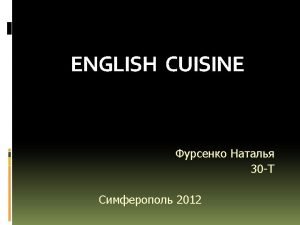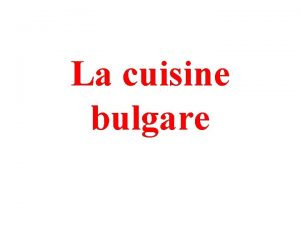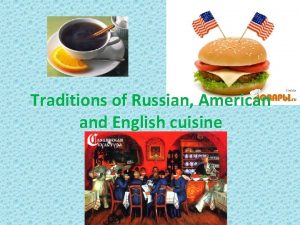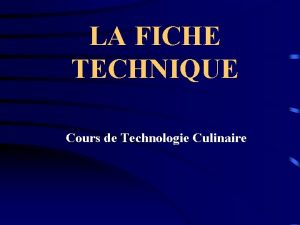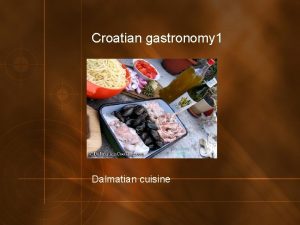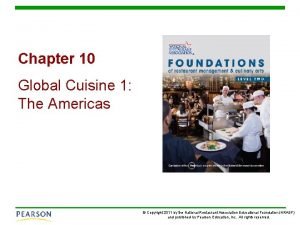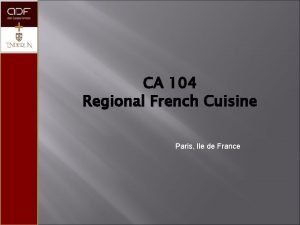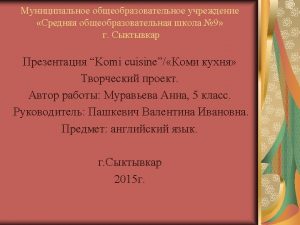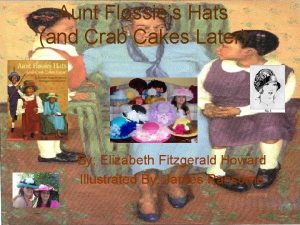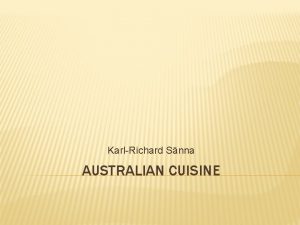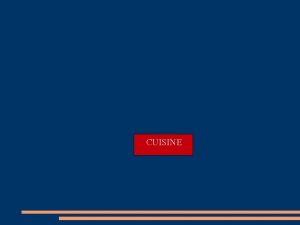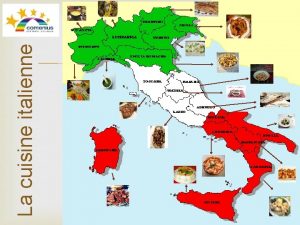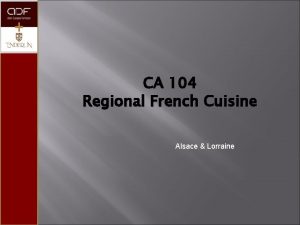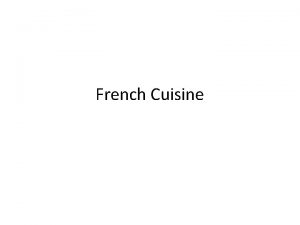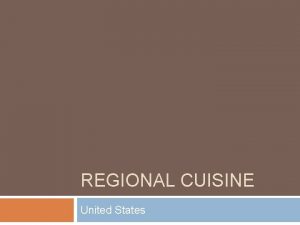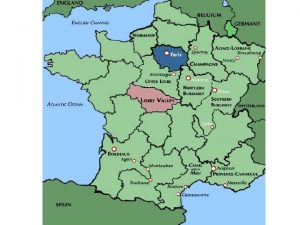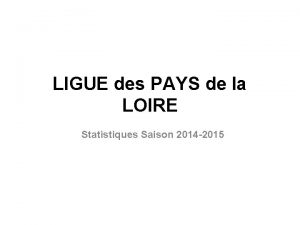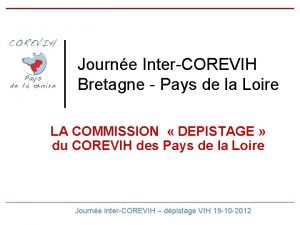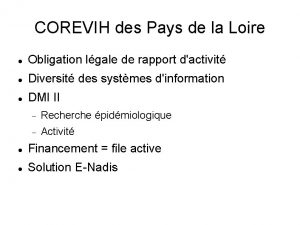CA 104 Regional French Cuisine Pays de Loire






































- Slides: 38

CA 104 Regional French Cuisine Pays de Loire / Centre

Pays de Loire Pays de la Loire is one of the regions created in the late 20 th century to serve as a zone of influence for its capital, Nantes, one of a handful so-called "balancing metropolises". Other examples of "artificially created" regions include Rhône-Alpes (Lyon), and Midi. Pyrénées (Toulouse).

Pays de Loire consist of various former historical departments: • Loire-Atlantique and it’s capital Nantes formerly belonged to Brittany. • The former province of Anjou. • The former province of Maine, which is now further divided into the departments Mayenne and Sarthe. • Parts of Poitou. • Part of Perche. A small part of Touraine. The Pays de Loire forms a region in western France. It is bounded to the north-west by Brittany and in the north by Normandy, while to the east, the center of France the Loire Valley and to the south-east by Poitou-Charentes. The Pays de Loire region consists of eight departments: Loire-Atlantique Sarthe Vendee Maine et Loire Mayenne The name “Pays de Loire (Lands of the Loire river) was chosen by the government and not based on historical development.

History in brief After displacing the powerful Cenomanni and Carnute tribes during the Iron Age, the Romans occupied what is now Pays de la Loire in 52 BC. They created the towns of Angers and Le Mans. Starting in 313, Christianity gained the ascendancy and the following centuries witnessed a series of invasions, notably the Vikings (9 th century). The end of the first millennium saw the rise of the counts of Maine and Anjou – the most famous being Henri Plantagenet, who was to become King of England. Returned to the French crown in 1202, the region became a platform for Renaissance ideas, including the cult of beauty in all fields: architecture, literature and music in the 16 th century. The region was not spared during the Wars of Religion (1562 -79) but the reign of King Louis XIV restored peace and order. The 1789 French Revolution met with fierce resistance in Maine and Anjou, which rejected the religious and administrative reforms that were imposed. Local armies rallied in support of the church and the king under the white flag (the royal color) and captured Saumur and Angers. In 1804 Napoleon founded La-Roche-sur-Yon as a stronghold to prevent further uprisings.

Pays de Loire – Land of the Loire – Cuisine Food and Gastronomy in Pays de la Loire are based on the geography of this Western region of France, the Atlantique ocean and the rich lands. Pays de la Loire's cuisine in French gastronomy is both important and influential. Some of the very staples in French cuisine come from this region: • Beurre Blanc sauce • Rillettes and pork specialties from Le Mans • Hams and brioche from Vendee • Mache lettuce and early vegetables from the Nantes Valley • Free range chicken an duck from Challans and Loué • Seafood from the Atlantic coast – oysters, mussels, shellfish and fish • Candies such as the Berlingots nantais, quernons d'ardoise in Anjou • Shortbreads in Retz or from Sablé-sur-Sarthe • Petit Beurre cookies from the famed LU factory, exported all over the world

Products – Pays de Loire Fish & Seafood • Pike perch • Pike • Eel • Sardines from Croix-de-Vie • Mussels from Anguillon • Oysters from Vendee • Vegetables • Asparagus • Onion • Leek • Tomatoes • Red radish • Shallots (gris-grey) • Pleurote – Oyster mushrooms • Meat & Poultry • Cornette d’Anjou (lettuce) • Farmhouse chicken from Loue • Pigeon • Beef (a l’herbe) from Maine • Fruits • Cassis • Rillettes from Mans • Strawberries • Duck (Challans) • Raspberries • Poultry (black) from Challans • Pears from Comice • Capon • Apples (Reinette) • Goose (white) from Poitou • Melon from Poitou • Dairy • Butter (AOC) Echire

Products of Pays de Loire – Challans poultry Le canard de Challans (Duck of Challans) Under the reign of king Phillip IV of Spain (1621 - 1665), many exiled Spaniards came to live in exile settled in Vendée & Brittany. They drained the land in order to started to breed ducks on it. These Challans duck ( a cross breed between wild and domesticated ducks) were supplied to Nantes in the early 18 th century. The traditional method of breeding leaves the ducks free throughout the farm and canals. The females mate not only with the ducks of the farm but also with wild ducks passing. The ducklings are either left to the female or given to the care of a dwarf hen. As they are growing, the ducklings are fed with what the farm provides but also with what they find - caterpillars, insects, slugs, snails and more. At 8 weeks (of age) they are kept in a pen for intensive fattening.

Products of Pays de Loire – Challans poultry The farming area of Challans duck is relatively narrow and extends into the coastal marshes. 35 kilometers along the coast and 15 kilometers inland north Vendee. This region is well suited to this animal because of its temperate climate, its soil in wetland fed by water channels that descend from the Loire Valley and Lake Grand Place and the minerals present in water and soil. It was at La Tour d'Argent, one of the most famous Parisian restaurants, the duck Challans has acquired its letters of nobility. The specialty of the Supreme Leader Claude Terrail is the "Duck Blood", served for over a hundred years to the restaurant table. On June 21, 1921, Hiro Hito, then Emperor of Japan, has tasted the duck and they have also been used in historical events, such as the marriage of Prince Rainier and Grace Kelly and a gala dinner on board the liner "France-Norway”.


Products of Pays de Loire – Echire Butter (AOC) Échiré unsalted butter owes its subtle, delicate taste and soft texture to the local soil and the traditional production process. The famed butter is produced in the small villages of Poitiers & La Rochelle, won AOC protected status, and is produced until today mostly by hand. Local people have reared cows in this remote corner of France since time immemorial. The milk from these cows produces butter which has a subtle and exquisite taste, quite unlike anything else. The name Échiré first appears in records dating from the year 1208. 85% of the production of Echire butter is kept in France and only 15% of it’s production is exported.


Beurre Blanc – White Butter Sauce It is said that the invention of the Beurre Blanc in 1887 is due to the Chef Clemence Lefeuvre’s oversights and shortcomings. At the time he was working for the Marquis de Goulaine and was supposed to prepare a Bearnaise. However he forgot the tarragon in the first place and did not whip the eggs ahead of incorporating the butter. What resulted is considered the first Beurre Blanc. The recipe for a basic beurre blanc has stayed essentially the same ever since: • Reduction of vinegar and wine (acidity to balance the butter) with aromatics (parsley stem, peppercorn, bay leaf, shallots and herbs as preferred) • “Monte au beurre” (incorporating) of cold Butter piece by piece into the reduction • Seasoning – salt & Pepper Variations – other liquid can be added to the reduction in order to achieve different flavor bases.

Products of Pays de Loire – Anguille - Eel True eels belong to the Anguilliforms family of fishes and consist of both freshwater and saltwater species. There are many different varieties of eels (600) and sizes range from rue eels 5 centimeters (one-jawed eel ) to 3. 75 meters (giant moray). They possess no pelvic fins, and many species also lack pectoral fins. The dorsal and anal fins are fused with the tail fin, to form a single ribbon running along much of the length of the animal. Most true eels prefer to dwell in shallow waters or hide at the bottom layer of the ocean, sometimes in holes. Only the Anguillidae family regularly lives in fresh water, and returning to the sea to breed (Catadromous). Generally speaking the fresh water eels are preferred to sea eels for taste and texture of flavors.


Traditional Dishes of Pays de Loire • Bouilleture d’anguilles – Eel stew A type of “pot au feu” with eel slowly braised in red wine with bacon and prunes, young vegetables and mushrooms. Brochet farci aux herbes – herb stuffed pike Chervil, thyme, parsley and shallots are stuffed into the pike and then the fish is poached in Loire valley wine. • Fricasse de Poulet – Poultry (chicken) fricasse A fricasse made with the local, grain fed free-range poultry. • Rilettes de Mans – Rilettes from Mans Salted pork is slowly cooked in it’s own fat until fork tender with the addition of spices. During the cooling process the rillettes is stirred every couple of minutes so the meat falls apart and builds a thick but spreadable past. Rilettes is generally eaten with dark bread. • Epoule de mouton a Langevin – Lamb shoulder “Langevin style” Oven baked, milk marinated lamb shoulder with mushrooms.


Traditional Dishes of Pays de Loire Desserts and Pastries Crepes a langevin –Crepes “Langevin style” White flour crepes with Mandarin & Cointreau sauce Sable de Sable-sur-Sarthe – Sable cookies Typical French Shortbread Poire Belle-Angevin au vin rouge – red wine poached pear Anjou red wine poached pear of the “belle-angevin” variety.


Traditional Dishes of Pays de Loire • Lu Cookies Since 1850, two young French bakers fell in love, married, and began creating exquisite biscuits together, which they proudly imprinted with their two initials, LU. Their passion for fine ingredients and distinctive, original biscuits inspires every LU we bake today.

Traditional Dishes of applied Laboratory • Quail with lentils • Confit of pork breast with onions in pie 1. History 2. Ingredients 3. Cooking method 4. Explanation of name

Centre – Loire Valley Départements: Loiret, Loir-et-Cher, Indre-et-Loire, and Maine-et-Loire Major Cities: Orleans, Tours, Bourges Climate: Pleasant, moderate climate with cold, but not freezing winters and warm, mild summers

The Centre (Valle de loire- loire valley) is not the geographical middle of France but rather one of the 26 departments of France. Centre is located to the south-west of Paris and borders onto the Pays de Loire in the west, Pouitou-Charentes in the south –west and Limousin in the south, while in the north Paris and Ile de France and in the East Burgundy complete it’s borders. The Loire valley is famous for one of the last stretches of river that has been untouched by man and for the over 300 castles and the architectural heritage it provides. Protected in 2000 by the UNESCO as a World Heritage site. Major Industries: Agriculture: • Wine - Famous Loire wine • Tourism

History in brief Generally following the same as for the Pays de Loire from the iron age until the invasion of Caesar in 52 BC Subsequently, they and the Druids unsuccessfully revolted against Caesar until Emperor Augustus brought peace. By the 4 th century, Saint-Martin, the greatest of all Gallic bishops, had assured complete acceptance of Christianity in the region. In the middle 5 th century the Huns invaded Orleans and in 507 the Frankish king Clovis conquered the area. In 732 The Saracens from Spain came into the area and subsequently were defeated by the Caroligian king, Charles Martel. In 9 th century, the Vikings raided the area bordering the Loire River. They were repulsed by Robert, the Count of Blois and Tours. By the 11 th & 12 th centuries, the powerful Loire barons (in their chateaux) dominated and only Orléans was firmly in French hands. In 1202, the entire Loire became French again. From 1337 to 1459, during the Hundred Years' War, the English reconquered most of the Loire and besieged Orléans. In 1429, Joan of Arc rallied the people of the Loire to drive the English out of France.

History in brief In 1202, the entire Loire became French again. From 1337 - 1459, (Hundred Years' War), the English re-conquered the Loire and besieged Orléans. In 1429, Joan of Arc rallied the people of the Loire to drive the English out of France. During the Renaissance, the power of the Catholic Church diminished along the Loire Valley. But, by 1540, the Roman Catholic Church llashed out against the reformation. In turn, Protestant Huguenots rose in 1560. In 1870 the Empire had already fallen when the Franco-Prussian War exploded upon France. Within a short period, the Bavarians captured Orléans. During the first World War, Tours served as the headquarters for the American Expeditionary Force. Shortly after start of the Second World War, the French Government moved to Tours and then to Bordeaux. On October 24, 1940, Marshal Pétan met Hitler in Montoire, (Loire) and agreed to terms for an Armistice. Control of the Loire was retaken by the Resistance & Allied forces in September, 1944. Centre was created in the 1970’s out of the provinces of Berry, Orléanais and Touraine.

Cuisine of Centre – Loire Valley The Centre region of France features THE "Cuisine du Terroir“. Rich products from the soil and reared as well as game meats. Produce from the former Touraine region includes tasty pork products, goat cheese such as the Sainte Maure and Grottin de Chavignol Anduillettes in simmered Vouvray wine and the Rillettes de Tours which is just as famed as the from Mans. But also sweet specialties are famous in the area, first and foremost the Tarte Tatin, Pithiviers & Financier.

Products –Centre – Loire Valley Fish Fruits Generally all varieties of fresh water • Pears fishes just like in the “Pays de Loire” • Melon, • Strawberries Meat & Poultry Products • Apples • Wild Game – pheasant, venison, • Quince wild boar, hare • Walnuts & walnut oil • Lamb –from Solognot • Hens (geline) from Tourraine Vegetables • Andouillette de Vauvray • Asparagus • Rillettes from Tours • Green peas • Potatoes Cheeses • Turnips • Crottin de cavignol • Lettuces • Saint-Maure • Green beans • Feuille de Dreux • Celery • Pithiviers au Foin • Green (PUY type) lentils • Olivet • Valencay

Products of Centre/Loire Valley – Goat Cheeses Sainte-Maure-de-Touraine Produced from raw, whole goats milk. This log-shaped goat cheese is AOC protected since 1990 and exclusively produced in Touraine. Invented during Arab invasions in the Carolingian period (8 th 9 th centuries), when goat breeding was first introduced it is produced in two variations as Saint-Maure-de Touraine (AOC) and Staint-Maure (Non AOC). In the middle of the log, a thin piece of straw is inserted into the cheese during the rolling/shaping of the log. For AOC cheeses this piece of straw is marked with the AOC emblem and a number indicating the producer. The cheese is aged for up to 6 weeks, which is unique for goat cheese which in general are fresh cheeses. The maybe coated in ash or not. Ash coating helps preservation.

Products of Centre/Loire Valley – Goat Cheeses Crottin Chavignol - Crottin de Chavignol Made around Sancerre & Berry, from unpasteurized goat's milk, (there is a pasteurized milk version for export). The word “crottin” means dropping and is said to have been produced since 1500’s. It reached AOC status in 1976. The cheese is shaped like a squat cylinder, about 2 1/2 cm tall, and 4 cm wide. A starter culture is added to the raw milk, then rennet is added to curdle the milk for 24 to 48 hours. The curd is drained through a cloth and ladled into moulds with small holes for further drainage. Then the cheeses are removed from the molds, salted, and aged for 10 days at 13 to 16 C. Each Crottin de Chavignol starts off weighing about 140 g fresh, loosing weight the longer it is aged. It can be eaten at any stage from fresh to very mature. At 6 weeks maturity, Crottin de Chavignol is dry, brittle, with a strong taste. The rind is hard and tastes even stronger. At 4 months, it can be too hard and strong for most people.


Products of Centre/Loire Valley – Fruit - Quince The Quince is the "pear shaped" fruit of the same named small tree and belongs to the seed fruits (botanically a pome fruit) just as apples and pears. Quince have been cultivated by the Greeks & Romans and the fruit is presumed older than apples. Early references to "the golden apple" in antique documents may refer to quince rather than apples Fully ripe, the fruit is bright yellow and hard with a shiny skin. Although there is a variety of Quince that can be eaten raw, the hard flesh of the fruit is usually not edible, it is excellent for jams, preserves or chutneys and can be used for stewing and baking. The flesh turns reddish-orange when cooked; the seeds need to be discarded as they are poisonous. Quince are best picked just before the first frost, but if left on the tree will get softer and edible after having been "frozen" a few of times. Quince are native to the Eastern Mediterranean but cultivated throughout the world in warmer climates in order to allow the fruits to fully mature in late autumn.

Products of Centre / loire Valley – Green Lentils La Lentille verte – French green lentils (Puy type) French green lentils (although brown when dried) are grown throughout the center of France, the Berry region (Centre) and further south in Auvergne (Puy lentils). Lentils belong to pulses in that they are solely grown for drying. The plants belongs to the legume family and grows low over the ground. The seed (lentil) is incased in an inedible pod usually two seeds to a pod. There are quite a few varieties of lentils on the market, but the French green lentil is known for it’s exquisite taste.

Traditional Dishes of Centre – Loire Valley Andouillettes au Vauvray – Andouille in Vauvray wine Andouillettes are smaller versions of regular Andouille sausages prepared with chitterlings. The most popular way to relish the Andouillettes sausages in the Centre region of France is to cook them with the local Vouvray wine. Andouillettes are then often accompanied with steamed or sautéed potatoes. Tarte au Rilettes The traditional Tours Rillettes – since the 15 th century. The pork specialty from Tours is the main rival of one from Le Mans. Touraine butchers claim, that Le Mans butchers like adding goose meat when Tours producers keep the authentic all-pork version. Often the rillettes is baked together with salted pork and a filling of egg, milk, parsley and chive. Sandre a la Vouvrillonie - Pike Perch “Vouvrillonne” style Generally, whole pike perch is baked on top of a matignon of vegetables and Vauvray wine in the oven and served straight in the baking dish Gigot de Sept Heures – lamb leg in Seven Hours Simmered lamb leg I aromatic herb broth cooked at low temperature for 7 hours in a cocotte.


Traditional Dishes of Centre – Loire Valley Civet de Marcassin – Ragout of baby wild boar “Civet” are game meat ragouts, where the meat is marinated in red wine vinegar, spices, mirepoix and red wine for at least 3 days. The meat is removed and well browned; the mirepoix separated for roasting vegetable; the marinate is boiled, strained and used for deglazing. The remaining preparation follows the same cooking methods as for any kind of stew in brown sauce. Ragout de biche – Brown stew of young venison Prepared according to traditional moist heat cooking method. Terrine de Lapin – Hare terrine Faisan au chou – Roast pheasant with cabbage Oven roasted pheasant on a bed of bacon studded white cabbage


Traditional Dishes of Centre – Loire Valley – Desserts & Pastries Nougat de Tours – Nougat tart from Tours A baked tart filled with a fluffy batter of eggwhites, candied fruits, almond poweder and icing sugar. Tarte Tatin – Upside-down apple pie Apples are caramelized, then arranged in a decorative matter in a baking mild. Topped with pie dough and baked with the dough on top of the apples. Contrasting stories in terms of the origin of the Tart Tatin trace back to 1898 and Stephanie Tatin, at the Hotel Tatin in Lamotte-Beuvrong in the Sologne region of the Centre. Phitiviers A enclosed, round pie made with puff pastry generally filled with frangipan and fruits such as apples, cherries or plums. Financier de Sully – Financier from Sully A light, fluffy almond sponge (tea cake) usually baked I small rectangular molds. The name "financier" derives from the traditional rectangular mold, which resembles a bar of gold. The basis of the cake itself is beurre noisette (brown butter), egg whites, flour, almond powder and powdered sugar.


Traditional Dishes of Centre –Loire Valley • Matelotte d’anguilles – Matelotte of eel • Boeuf Bourguinon – Beef “Bourguinon” style • History of these dishes • Regional origin • Ingredients of dishes
 Pays de la loire food
Pays de la loire food Formation cnfpt pays de la loire
Formation cnfpt pays de la loire Mondex smartcard
Mondex smartcard Gilles vigneault mon pays
Gilles vigneault mon pays French cuisine history
French cuisine history Fdva maine et loire
Fdva maine et loire Trajet de la loire
Trajet de la loire French regional accents
French regional accents Lht blois
Lht blois Czech cuisine of perversions
Czech cuisine of perversions Typical english food
Typical english food Lafeasta
Lafeasta Cuisine rhyme
Cuisine rhyme Is poland considered eastern europe
Is poland considered eastern europe Nested quantifiers exercises
Nested quantifiers exercises Youtube cuisine française
Youtube cuisine française Chinese cuisine logo
Chinese cuisine logo English cuisine
English cuisine Traditional azerbaijani cuisine
Traditional azerbaijani cuisine English cuisine encompasses
English cuisine encompasses Brigade kitchen definition
Brigade kitchen definition Czech cuisine presentation
Czech cuisine presentation Le grillardin
Le grillardin Nourriture bulgare
Nourriture bulgare American cuisine
American cuisine Les types de cuisine
Les types de cuisine China cuisine
China cuisine Fiche technique d'un cours
Fiche technique d'un cours Modern kitchen brigade
Modern kitchen brigade Marche en avant dans le temps
Marche en avant dans le temps Dalmatian cuisine
Dalmatian cuisine Chapter 10 global cuisine 1 the americas
Chapter 10 global cuisine 1 the americas Pppst.com
Pppst.com Carnet personnel de techniques professionnelles cap cuisine
Carnet personnel de techniques professionnelles cap cuisine Ile de france food specialties
Ile de france food specialties Anna komi
Anna komi Ppt on odisha
Ppt on odisha Referentiel cap cuisine
Referentiel cap cuisine In french in french
In french in french
